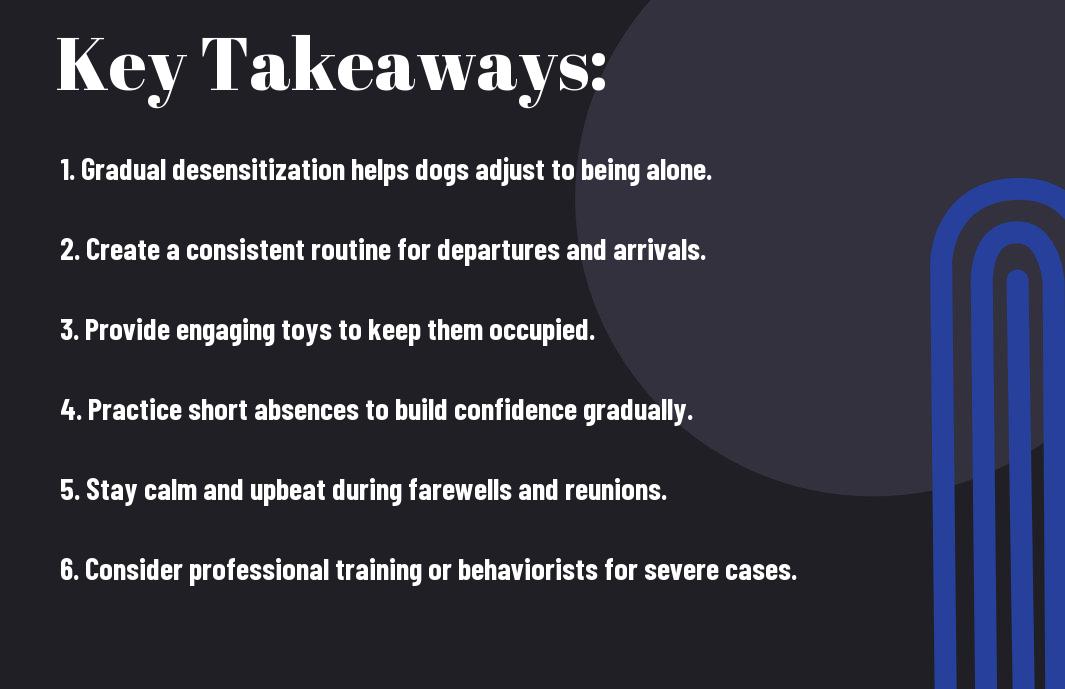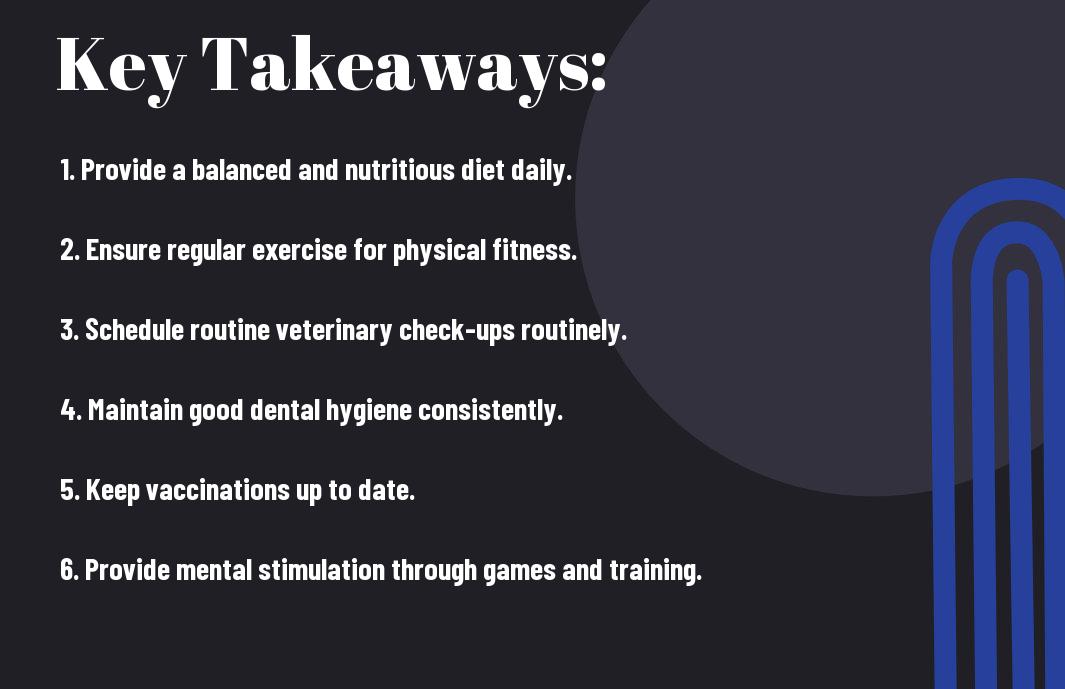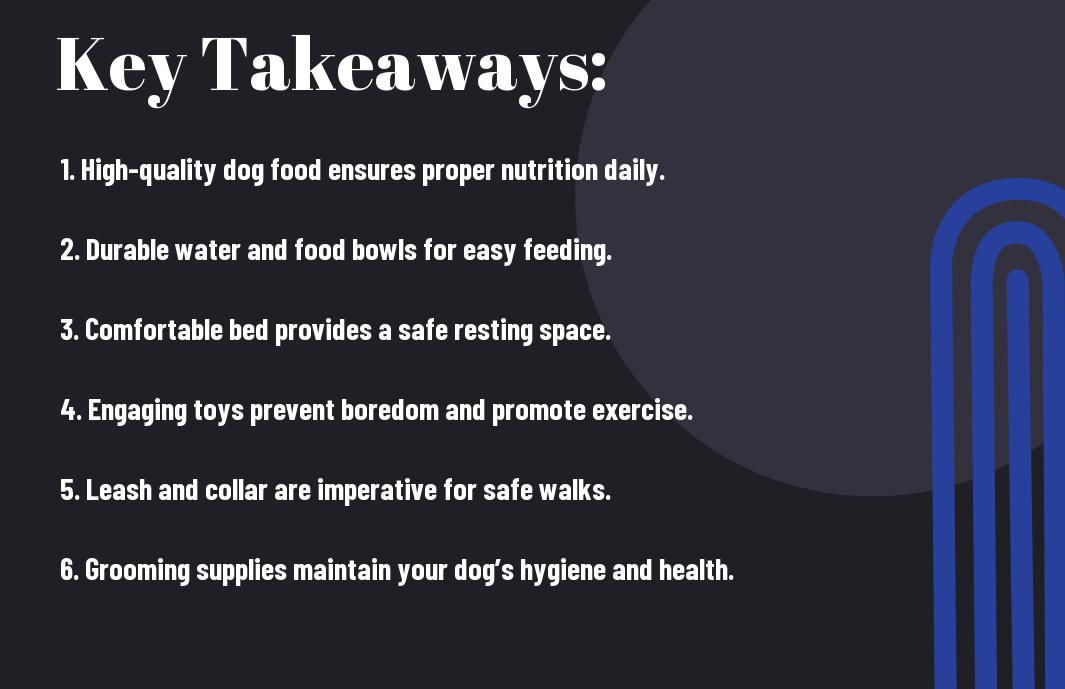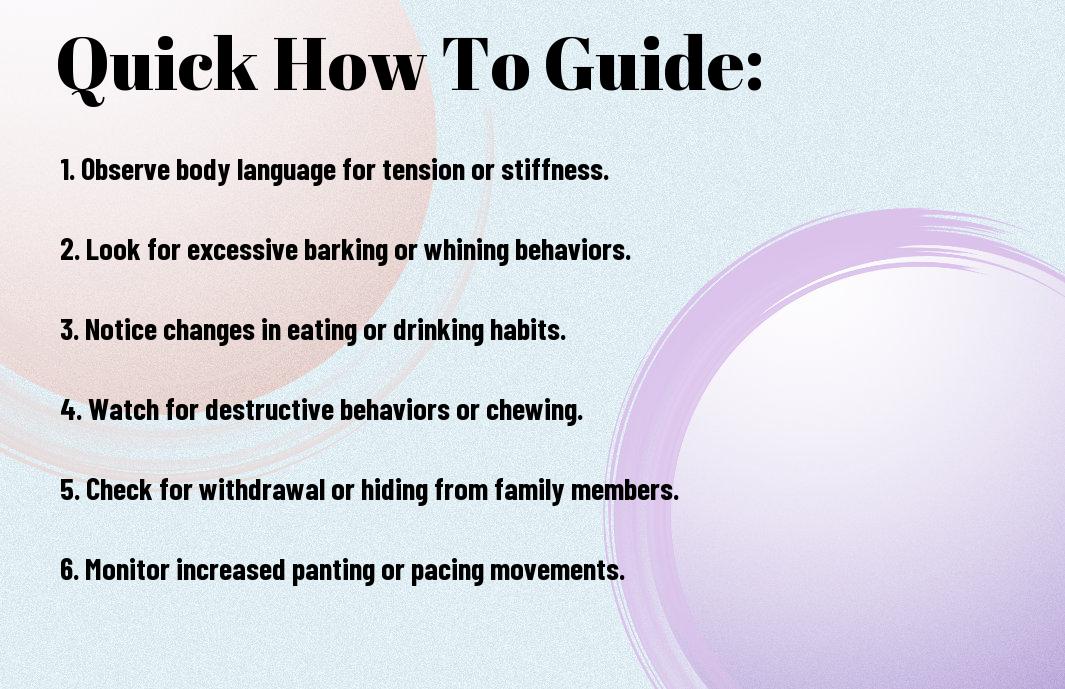Dogs thrive on companionship, so when you leave them alone, they can often feel stressed and anxious. This separation anxiety can lead to destructive behaviors and excessive barking if left unaddressed. Fortunately, you can help your furry friend manage their feelings and develop a sense of security while you’re away. In this post, you’ll discover effective strategies to ease your dog’s anxiety, promote their emotional well-being, and ultimately strengthen your bond while ensuring your pet remains calm and happy in your absence.
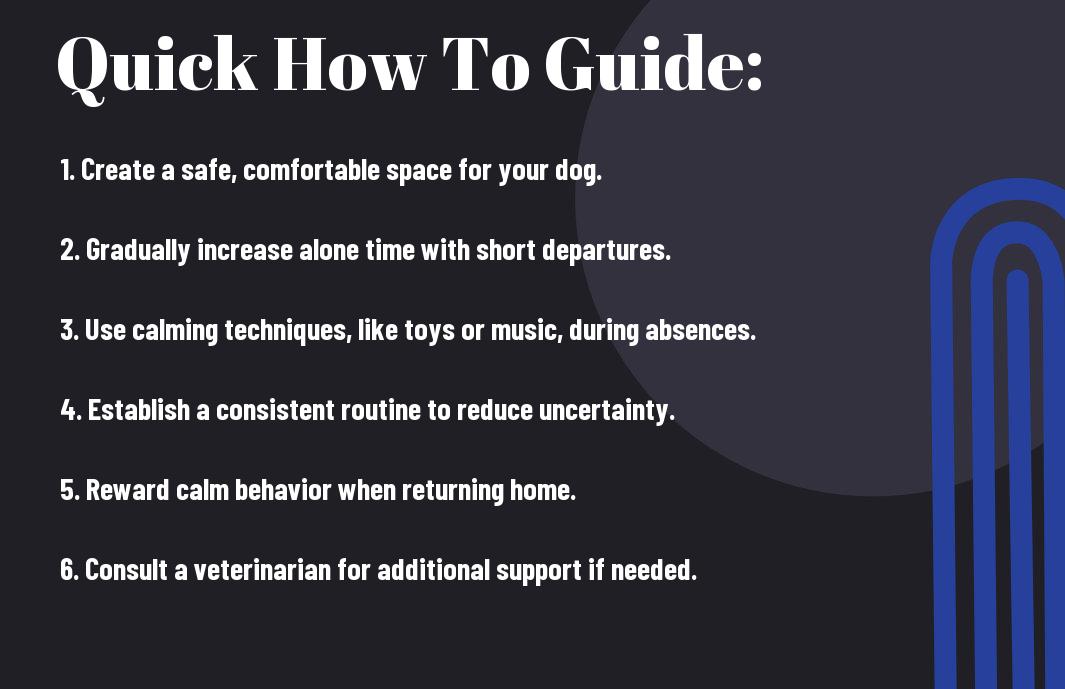
Understanding Separation Anxiety
To effectively help your dog overcome separation anxiety, it’s imperative to first understand what this condition entails. Separation anxiety occurs when your pet becomes excessively distressed or anxious when left alone or separated from you. This behavior can manifest in various ways and can significantly affect your dog’s well-being and your peace of mind.
What Is Separation Anxiety?
One of the most common issues faced by dog owners today is separation anxiety. It is characterized by behaviors such as barking, whining, destruction, and even attempts to escape when a dog is left alone. This emotional disorder can develop when dogs feel abandoned, leading to stress and fear whenever they perceive they are being left behind.
Understanding the phenomenon of separation anxiety is vital in finding effective solutions to help your furry friend. In various cases, this anxiety may stem from a lack of socialization during their early development stages, significant changes in their environment, or traumatic experiences related to being alone.
Common Symptoms of Separation Anxiety
What distinguishes separation anxiety from other behavioral problems is its specific symptoms. Dogs suffering from this condition may show signs such as excessive barking or howling, destructive behaviors like chewing furniture, house soiling, and attempts to escape. These actions are not merely mischief but genuine expressions of fear and distress triggered by your absence.
Understanding these symptoms can help you identify when your dog is struggling with anxiety. Some dogs may pace restlessly or excessively follow you around the house, while others might become notably withdrawn or aggressive. Being observant will allow you to intervene and provide the necessary support for your pet.
Factors Contributing to Separation Anxiety
An array of factors can contribute to your dog’s separation anxiety. These include a lack of socialization, prior trauma, and changes in routine. Dogs that were not adequately exposed to being alone during their formative period may struggle more intensely when faced with solitude. Additionally, significant changes in the household, such as moving to a new home or the loss of a family member, can escalate anxiety levels.
- Lack of socialization
- Trauma
- Changes in routine
After identifying these factors, you can take proactive steps to help your dog acclimate to being alone in a more positive way.
An understanding of the factors contributing to separation anxiety is key to addressing it effectively. Dogs that have experienced abandonment or were adopted from shelters may carry emotional baggage that manifests as anxiety during separations. Other influences might be due to the age of the dog; younger pups or senior dogs may exhibit different reactions to being left alone.
- Abandonment
- Age
- Environment changes
After recognizing these elements, you will be better equipped to support your dog through their anxiety and develop a tailored plan for improvement.
Assessing Your Dog’s Situation
There’s a lot to understand about your dog’s emotional state when it comes to separation anxiety. Assessing your dog’s situation is the first step in helping him or her cope more effectively with being alone. This involves observing specific behaviors and identifying patterns that may provide insight into what triggers your dog’s anxiety. By taking the time to understand what your dog is experiencing, you can devise a plan to mitigate these feelings of distress.
Observing Behavior During Departures
Situation plays a significant role in uncovering the depth of your dog’s separation anxiety. When you prepare to leave, your dog may exhibit a range of behaviors, such as whining, barking, or pacing. Paying attention to these signs can help you gauge the intensity of his or her emotional response. Additionally, you may notice that your dog shows less anxiety when you leave for short periods compared to longer absences, which can help you understand how your dog’s anxiety manifests.
Identifying Triggers and Stressors
On your journey to help your dog, pinpointing the specific triggers and stressors is crucial. Various elements could be causing your dog’s anxiety—these could range from the sound of doorbells, the sight of you getting ready to leave, or even the absence of familiar scents in the environment. Keeping a log of your dog’s behavior and noting the circumstances surrounding each episode of anxiety will give you a clearer picture of what might be causing the issue.
Identifying these triggers allows you to create a tailored approach to your dog’s training and comfort. You may find that certain situations or objects, like a favorite toy or blanket, can help alleviate anxiety when left behind. By understanding what makes your dog feel anxious, you can begin to desensitize him or her to those triggers, gradually helping your dog feel more secure when alone.
Importance of a Calm Environment
Some elements in your home environment play a significant role in your dog’s overall comfort. A calm and consistent environment can help your dog feel safer and more secure during your absences. Creating a designated space for your dog with familiar scents, such as bedding or clothing, can offer them a sense of security. Moreover, making this area a positive and relaxing place can shift your dog’s focus from anxiety to comfort.
Environment also encompasses the overall atmosphere in your home. Reducing loud noises and chaotic activities can enhance your dog’s sense of peace. Consider implementing background noise like soft music or white noise during your departures, which may help mask unsettling sounds that trigger anxiety. Ultimately, instilling a sense of calm within your home environment is key to lessening your dog’s feelings of distress when faced with separation.

Prevention Strategies
Unlike managing separation anxiety after it has become an issue, prevention is all about laying the groundwork to ensure your dog feels secure and relaxed when left alone. By implementing specific strategies, you can greatly reduce the likelihood of your pet developing separation anxiety. Consider investing time in techniques that enhance your dog’s confidence and adaptability when faced with solitude.
Early Socialization Techniques
Prevention begins with early socialization. Exposing your dog to a variety of people, animals, and environments while they are still a puppy can help them develop a sense of security and confidence. This process can involve arranging playdates with other dogs, enrolling in puppy classes, or inviting friends over to meet your new companion. The more experiences your dog has, the more equipped they will be to handle various situations without excessive anxiety.
Additionally, socialization isn’t purely about the encounters themselves; it’s also about teaching your dog to comfortable and relaxed in those scenarios. Positive reinforcement during these interactions can help your dog associate unfamiliar situations with pleasant experiences, making them more resilient when left alone.
Establishing a Routine
With consistent routines, dogs thrive and feel more secure in their environment. Establish a predictable daily schedule that includes regular feeding times, walks, and play sessions. Knowing what to expect can alleviate anxiety, as your dog will feel a sense of stability and familiarity. It’s also beneficial to practice short departures during these times to help prepare your dog for being alone.
The routine you establish should gradually evolve to include intervals where your dog is left alone for short periods. This way, you help them adapt to separation in a controlled manner. Over time, you can increase the length of these absences, reinforcing the idea that you will always return. Making departures and arrivals low-key also helps minimize the emotional impact of leaving and returning, promoting a calm atmosphere.
Gradual Desensitization
Gradual desensitization is another effective strategy that involves slowly getting your dog used to being alone. Begin by leaving your dog for very short periods, just a few minutes, and gradually increase this time as they become more comfortable with being alone. This method allows your pet to build confidence while recognizing that your absence isn’t something to be anxious about.
Routine practice of leaving your dog alone for incremental lengths of time helps reinforce a positive association with solitude. During this process, you can use treats or toys to distract your dog and redirect their attention while you are away. The goal is to reduce their dependency on your presence, promoting independence and relaxation when you’re not home.
Routine practice of desensitization is most effective when conducted consistently and intertwined with your existing routine. This structured approach ensures that your dog learns that being alone can be a part of life without inciting anxiety. When done correctly, it can serve as a powerful tool to fortify your dog’s confidence.
Practical Tips for Overcoming Separation Anxiety
Despite the challenges of separation anxiety, there are effective strategies you can implement to help your dog feel more secure when you leave. Here are some practical tips to consider:
- Create a safe space for your dog.
- Use positive reinforcement techniques.
- Invest in interactive toys and puzzles.
- Gradually increase your departure time.
- Consult a professional trainer or behaviorist if necessary.
Knowing the right approaches can significantly ease your dog’s distress and help build their confidence during your absences.
Creating a Safe Space
Overcoming your dog’s anxiety begins with establishing a safe space where they can feel relaxed and comfortable. This area should be free of distractions and equipped with their favorite items, such as bedding, toys, and even a piece of your clothing, so they can feel your presence even when you are not home. Designate a specific area, like a cozy corner or a crate, where they can retreat. This will serve as their sanctuary where they can gather their thoughts and unwind, making your departures less stressful.
Additionally, consider the use of calming aids such as anxiety wraps or pheromone diffusers that can help create a soothing environment. By providing your dog with a familiar and cozy area, you help reinforce a sense of security that can be vital in reducing their stress levels when you leave.
Using Positive Reinforcement
Overcoming separation anxiety also greatly benefits from the use of positive reinforcement. This method encourages desired behaviors by rewarding your dog when they handle being alone well. Start by associating your departures with something positive, like giving your dog a special treat just before you leave. Make your departures low-key, so your dog does not feel overly anxious about your comings and goings, and reward them each time they remain calm.
Consistency is paramount here. Make sure to practice these positive reinforcement strategies regularly. Every small success should be acknowledged—this helps build your dog’s confidence and shows them that being alone can be a positive experience.
Positive reinforcement not only helps alleviate your dog’s anxiety but also strengthens your bond. As you reward your dog for calm behaviors during your absence, they learn that being alone is okay and that good things can happen while you’re gone. This can lead to a more relaxed and well-adjusted pet who no longer associates your departures with stress and worry.
Interactive Toys and Puzzles
Tips for engaging your dog’s mind through interactive toys and puzzles can significantly help reduce their anxiety. These toys can keep your dog occupied and mentally stimulated, providing a healthy distraction when you leave. There are various options available that dispense treats or require problem-solving skills, which can captivate your pet’s attention, making them less focused on your absence.
Incorporating these stimulating toys into your dog’s routine can promote independence and alleviate boredom, both of which are key factors in managing separation anxiety. Additionally, rotating the toys regularly can maintain your dog’s interest and excitement, enhancing their playtime experience.
Anxiety can manifest in many forms, and having interactive toys encourages your dog to engage actively with their environment. This engagement helps divert their attention away from you leaving and turns it into a fun and rewarding experience, making them less anxious over time.

Training Techniques
Keep in mind that training your dog to overcome separation anxiety often requires a combination of techniques, patience, and consistency. The goal is to help your pet feel secure in their environment, making them less anxious when you’re away. One of the most effective ways to build that sense of confidence is through basic commands. By teaching your dog commands like “sit,” “stay,” and “come,” you provide them with structure and expectations that can help reduce anxiety.
Basic Commands to Build Confidence
Little by little, as your dog masters these commands, their self-esteem will grow. They will start to understand that there are boundaries and rules that they can follow, which can significantly reduce their feelings of uncertainty when you leave. This training not only helps your dog listen but also strengthens the bond between you and your pet, making them feel more connected to you.
Crate Training as a Solution
Solution-based training techniques can further assist in easing your dog’s separation anxiety, with crate training being a highly effective method. A crate can become a safe haven for your dog, a cozy space where they feel secure when they are left alone. When you properly introduce your dog to the crate as a positive environment, it can transform their perception of being left alone.
To ensure the crate is a beneficial tool for your dog, make it as inviting as possible. Use soft bedding, toys, and maybe even a piece of your clothing inside the crate to create an element of comfort. Gradually get your dog accustomed to being in the crate for short bouts, rewarding them with treats and praise. This approach will help your dog associate the crate with positive feelings, making it easier for them to relax when you are not around.
Engaging in Engrossing Activities
Engaging in engrossing activities is another effective way to combat separation anxiety. Providing your dog with mental and physical stimulation can keep them busy and help them feel more secure when you are away. Activities could include puzzle toys, interactive treat dispensers, or even a good old-fashioned game of fetch before you leave. This not only helps to tire them out but also diverts their attention from your absence.
Basic activities like these create a sense of purpose and engagement for your dog. The more you enrich their daily routine with these types of activities, the less time they spend worrying about your absence, which helps to alleviate separation anxiety in the long run. You’ll find that your dog’s behavior improves, making your time apart easier for both of you.
Seeking Professional Help
For many dog owners, the journey to assist their furry companions in overcoming separation anxiety may lead them to seek professional help. Working with experienced professionals can provide you with tailored strategies and techniques designed specifically for your dog’s needs. The decisions you make can significantly impact your dog’s well-being, making it crucial to choose wisely when determining the best path forward.
When to Consult a Veterinarian
Any time you suspect your dog is struggling with severe separation anxiety, it’s wise to consult your veterinarian. Your vet can help rule out any underlying medical conditions that might contribute to your dog’s anxiety, such as hormonal imbalances or chronic pain. Additionally, they can provide valuable insights into whether your dog’s behavior is indicative of a more serious issue.
Any signs of distress, such as excessive barking, destructive behavior, or self-harm when left alone, should be taken seriously. Your veterinarian can recommend the appropriate interventions that may include behavioral assessments, nutritional adjustments, or even referrals to specialists who focus on animal behavior.
Working with a Certified Dog Trainer
Even when you have tried various techniques at home, it may be beneficial to work with a certified dog trainer who specializes in behavioral issues. A professional trainer can evaluate your dog’s specific needs and create a plan that utilizes positive reinforcement methods to alleviate anxiety. They can also help you develop consistency in your training, which is key to experiencing real change.
Certified dog trainers bring a wealth of knowledge and experience to the table. They can provide you with tools that empower you and your dog to work through the anxiety together, ultimately creating a calmer environment for both of you. Additionally, trainers can help you learn to recognize triggers and develop strategies that reinforce your dog’s feelings of safety and security when you are away.
Exploring Medication Options
Any time you’re considering medication for your dog’s separation anxiety, it’s important to have a thorough discussion with your veterinarian. Certain medications can be helpful in managing anxiety symptoms, but they are often most effective when combined with behavioral training. Your veterinarian can help guide your decision based on your dog’s specific needs and health history.
Any medication should always be viewed as a supplement to behavioral modifications rather than a standalone solution. It can take time to find the right course of treatment, and gradual adjustments may be necessary to ensure your dog is comfortable and responding positively. It’s vital to monitor your dog closely during this process and work in close collaboration with your veterinarian to achieve the best outcome.
It’s crucial to approach the idea of medication with an informed mindset, as not all dogs respond the same way to treatment. Be prepared for the possibility of side effects and remain in close contact with your veterinarian to adjust the treatment plan as needed for your dog’s health and well-being.
Summing up
Considering all points, addressing your dog’s separation anxiety requires a blend of patience, understanding, and consistent training techniques. You can start by creating a safe and comfortable space for your dog, establishing a routine, and gradually desensitizing them to your absence. Utilizing positive reinforcement when your dog displays calm behavior can also be remarkably effective in helping them learn that being alone doesn’t equate to fear or abandonment. Engaging in training exercises and providing mental stimulation through toys can help ease your dog’s anxiety and promote a sense of security.
As you implement these strategies, it’s important to observe your dog’s progress and adapt your approach accordingly. Each dog is unique, and what works for one may not work for another. You may also consider consulting a professional trainer or a veterinarian if anxiety persists despite your efforts. By actively working to alleviate your dog’s separation anxiety, you not only enhance their well-being but also strengthen the bond you share, resulting in a happier, healthier life together.
FAQ
Q: What are the signs of separation anxiety in dogs?
A: Dogs with separation anxiety may show various signs when they are left alone or anticipate being alone. Common behaviors include excessive barking or howling, destructive actions such as chewing furniture or digging, and attempts to escape confined spaces. Additionally, a dog may exhibit pacing, loss of appetite, or attempting to stay close to their owner at all times. Recognizing these signs early can help you take appropriate steps to assist your dog in overcoming their anxiety.
Q: What training techniques can help alleviate my dog’s separation anxiety?
A: Gradual desensitization is one effective training method. This involves slowly getting your dog used to being alone by starting with short periods and gradually extending the duration as they become more comfortable. Positive reinforcement can also play a significant role; reward your dog with treats or praise when they remain calm while you are away. Additionally, teaching your dog to associate your departures with enjoyable experiences, such as providing puzzle toys or treats that they only receive when you leave, can help reduce anxiety.
Q: Are there any natural remedies or products that can assist with my dog’s separation anxiety?
A: Yes, several natural remedies may support your dog’s emotional well-being. Herbal supplements such as valerian root or chamomile have been known to have calming properties. Additionally, products like pheromone diffusers or calming collars can release natural scents that help relax your dog. It’s also beneficial to establish a comforting environment by providing a cozy space filled with their favorite blankets and toys. Always consult your veterinarian before introducing new products or supplements to ensure they are safe and appropriate for your dog.
